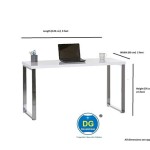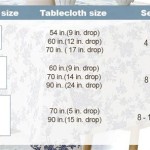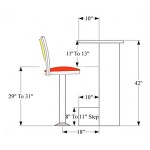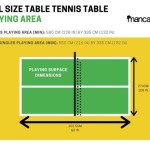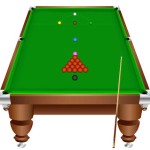Living Spaces Dining Tables: A Comprehensive Guide
The dining table serves as a central point in many homes, a gathering place for meals, conversations, and shared experiences. Living Spaces, a furniture retailer, offers a diverse selection of dining tables designed to suit various tastes, spatial requirements, and budgetary constraints. This article provides a comprehensive overview of Living Spaces dining tables, encompassing different styles, materials, sizes, and factors to consider when selecting the right table for a particular home.
Understanding Different Dining Table Styles
Living Spaces categorizes its dining tables into a range of styles, each with distinct characteristics. These styles often reflect broader trends in interior design and can significantly influence the overall aesthetic of a dining space.
Modern: Modern dining tables typically feature clean lines, minimalist designs, and a focus on functionality. They may incorporate materials such as metal, glass, and engineered wood. Shapes are often geometric, with rectangular or round tables being common. Modern dining tables prioritize a streamlined look, often foregoing ornate details in favor of simplicity.
Contemporary: Contemporary dining tables share similarities with modern styles but often incorporate more current trends and a wider range of materials. They may include elements of different styles, creating a more eclectic and evolving aesthetic. Contemporary tables might feature unconventional shapes, unique leg designs, or a mix of materials like wood and acrylic.
Traditional: Traditional dining tables evoke a sense of formality and timeless elegance. They often feature rich wood finishes, ornate carvings, and substantial construction. Common shapes include rectangular and oval tables, often with pedestal bases or cabriole legs. Traditional dining tables are often associated with a more formal dining room setting.
Rustic: Rustic dining tables embrace natural materials and a more relaxed, informal aesthetic. They often feature reclaimed wood, distressed finishes, and visible wood grain. Rustic tables may have a more rugged appearance, with imperfections and knots adding to their character. This style is well-suited for creating a warm and inviting dining space.
Farmhouse: Farmhouse dining tables are similar to rustic styles but often incorporate a more refined and curated aesthetic. They typically feature solid wood construction, often with a painted or distressed finish. Farmhouse tables often have a simple, rectangular shape and are designed to accommodate large gatherings. This style emphasizes comfort and practicality.
Mid-Century Modern: Mid-century modern dining tables are characterized by their clean lines, tapered legs, and use of natural materials like wood. They often feature simple, unadorned designs that prioritize functionality and aesthetics. This style is known for its timeless appeal and versatility.
Materials and Construction of Living Spaces Dining Tables
The materials used in the construction of a dining table significantly impact its durability, appearance, and overall value. Living Spaces offers dining tables made from various materials, each with its own advantages and disadvantages.
Solid Wood: Solid wood dining tables are known for their durability, beauty, and longevity. Different types of wood, such as oak, maple, acacia, and pine, offer varying degrees of hardness, grain patterns, and color variations. Solid wood tables are generally more expensive than those made from engineered wood, but they can last for generations with proper care.
Engineered Wood: Engineered wood, such as MDF (Medium-Density Fiberboard) and plywood, is a cost-effective alternative to solid wood. These materials are made by bonding wood fibers or veneers together with adhesives. Engineered wood is often more stable than solid wood, meaning it is less prone to warping or cracking. It is also a good option for tables with intricate designs or curved shapes.
Metal: Metal dining tables are often used in modern and industrial-style settings. They may feature steel, iron, or aluminum frames, which provide strength and stability. Metal tables can be paired with wood or glass tops to create a variety of looks. They are generally durable and easy to clean.
Glass: Glass dining tables offer a sleek and contemporary aesthetic. They can make a small space feel larger and more open. Glass tabletops are typically made from tempered glass, which is stronger and more shatter-resistant than regular glass. Glass tables require regular cleaning to maintain their appearance.
Stone: Stone dining tables, such as those made from marble or granite, offer a luxurious and sophisticated look. They are incredibly durable and resistant to scratches and stains. Stone tables are typically heavy and require a sturdy base to support their weight. They are also a more expensive option.
The construction of a dining table also plays a crucial role in its stability and longevity. Look for tables with solid joinery, such as mortise and tenon joints or dovetail joints. The base should be sturdy and well-supported. Consider the weight capacity of the table, especially if you plan to use it for large gatherings.
Selecting the Right Size and Shape of Dining Table
Choosing the appropriate size and shape of a dining table is essential for creating a functional and comfortable dining space. The size of the table should be proportional to the size of the room, and the shape should complement the overall layout.
Rectangular: Rectangular dining tables are the most common and versatile shape. They work well in long, narrow rooms and can accommodate a large number of people. Rectangular tables are ideal for formal dining settings.
Round: Round dining tables are a good option for smaller spaces and promote conversation. They allow everyone at the table to see and interact with each other. Round tables are also a good choice for square rooms.
Square: Square dining tables are suitable for small spaces or for seating two to four people. They create a more intimate dining experience. Square tables can also be used as accent tables in other areas of the home.
Oval: Oval dining tables are similar to rectangular tables but with rounded ends. They offer a softer look and can be a good compromise between rectangular and round shapes. Oval tables work well in a variety of room sizes.
Extending Tables: Extending dining tables are a practical choice for those who occasionally need to accommodate larger groups. These tables can be expanded by adding leaves, providing extra seating when needed. Extending tables are a good option for smaller homes where space is limited.
When determining the appropriate size of a dining table, consider the following factors: the number of people you typically seat, the size of your dining room, and the amount of space you need around the table for comfortable movement. A general rule of thumb is to allow at least 36 inches of space between the edge of the table and the walls or other furniture.
Additional Considerations When Purchasing a Dining Table
Beyond style, materials, and size, several other factors should be taken into account when purchasing a dining table from Living Spaces.
Budget: Living Spaces offers dining tables at various price points. Setting a budget beforehand can help narrow down the options and prevent overspending. Consider the long-term value of the table and invest in a quality piece that will last for many years.
Chair Selection: The dining chairs should complement the style of the table and provide comfortable seating. Consider the height of the chairs and the table to ensure that there is adequate legroom. The chairs should also be durable and easy to clean.
Room Décor: The dining table should coordinate with the overall décor of the room. Consider the color scheme, the style of other furniture, and the existing architectural features. The table should enhance the aesthetic of the space and create a cohesive look.
Maintenance: Different materials require different levels of maintenance. Solid wood tables may need to be oiled or waxed periodically to protect the finish. Glass tables require regular cleaning to remove fingerprints and smudges. Consider the amount of time and effort you are willing to invest in maintaining the table.
Delivery and Assembly: Check Living Spaces' policies regarding delivery and assembly. Some tables may require professional assembly, while others can be easily assembled at home. Factor in the cost of delivery and assembly when calculating the total cost of the table.
Warranty: Review the warranty offered by Living Spaces. A good warranty can protect you against defects in materials and workmanship. Understand the terms and conditions of the warranty before making a purchase.
Customer Reviews: Read customer reviews to get an idea of the quality and durability of the table. Pay attention to comments about assembly, customer service, and overall satisfaction. Customer reviews can provide valuable insights that can help you make an informed decision.
By considering these factors, potential buyers can narrow down their options and select a Living Spaces dining table that meets their specific needs and preferences. The dining table should be both functional and aesthetically pleasing, creating a welcoming and enjoyable dining experience for years to come. The ultimate goal is to create a space where meals are enjoyed, memories are made, and connections are strengthened.

Dining Tables To Fit Your Room Decor Living Spaces

60 Dining Room Ideas To Create A Warm Gathering Space Living Spaces

Dining Room Furniture Collection Living Spaces

Modern Dining Room Ideas To Update Your Space Tables Chairs And Sets With Clean Lines Farmhouse

60 Dining Room Ideas To Create A Warm Gathering Space Living Spaces

60 Dining Room Ideas To Create A Warm Gathering Space Living Spaces

60 Dining Room Ideas To Create A Warm Gathering Space Living Spaces

2024 Construction Trend Multi Functional Living Spaces

Make Open Plan Living Spaces Cosy Ez Interiors

Rory Dining Side Chair Brown 85 Chairs Extension Table Living Spaces Furniture

